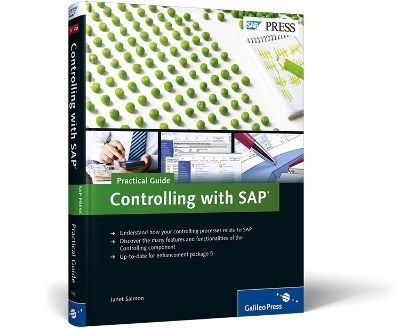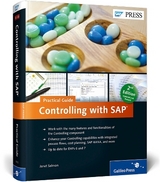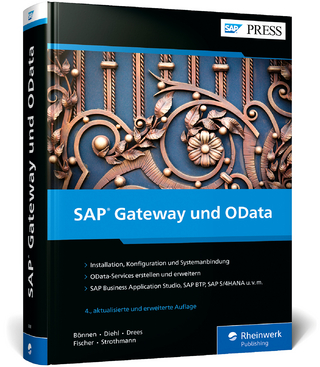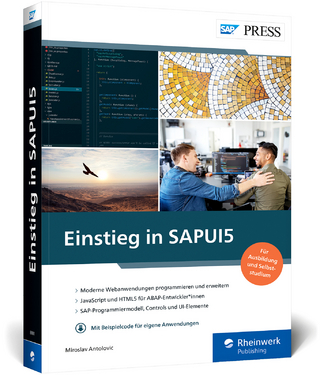
Controlling with SAP
SAP Press (Verlag)
978-1-59229-392-6 (ISBN)
- Titel z.Zt. nicht lieferbar
- Versandkostenfrei innerhalb Deutschlands
- Auch auf Rechnung
- Verfügbarkeit in der Filiale vor Ort prüfen
- Artikel merken
Janet Salmon joined SAP in 1992, working first as a translator and then a technical writer for Product Cost Controlling. She received an award from the Society of Technical Communication for Functions in Detail: Product Cost Controlling in 1998, where the judges described her brochure as ""refreshingly free of fluff"". She began working as a product manager/solution manager for the Product Costing area in 1995 and gradually began covering Profitability Analysis and Overhead Controlling. She began writing articles for the SAP Financials Expert in 2003. She is a regular speaker on Controlling at conferences including: ASUG, SAP Financials (US and Europe), and Mastering SAP Financials (Australia).
Preface 15
1 Introduction 25
1.1 Basic Controlling Functions 28
1.1.1 Goals of Controlling 29
1.1.2 Cost Accounting in the United States 31
1.1.3 Standard Costs and Actual Costs 32
1.1.4 Investment and Project Controlling 32
1.1.5 Lean Accounting 33
1.2 Essential Record Keeping Functions 33
1.2.1 Record Keeping by Cost Center 35
1.2.2 Record Keeping by Order 38
1.2.3 Record Keeping by Project 39
1.3 Managing Close and Valuation Processes 40
1.3.1 Valuation of Goods Movements 40
1.3.2 Work in Process 41
1.3.3 Scrap 41
1.3.4 Work in Process for Projects 42
1.4 Preparing Budgets and Planning 43
1.4.1 Driver-Based Cost Planning 43
1.4.2 Driver-Based Cost Planning Between Cost Centers 45
1.4.3 Budgeting 46
1.5 Process Analysis and Internal Controls 47
1.5.1 Master Data Controls 47
1.5.2 Workflow 48
1.5.3 Process Controls 48
1.6 Summary 49
2 Reporting 51
2.1 Cost Center Line Items 52
2.1.1 Classic Cost Center Line Item Report 52
2.1.2 Simplified Cost Center Line Item Report 59
2.1.3 Totals Records for Cost Centers 61
2.2 Order Line Items 62
2.2.1 Classic Order Line Items 63
2.2.2 Simplified Order Line Items 65
2.3 Product Costs: Itemization 65
2.3.1 Classic Reports for Product Cost Reporting 67
2.3.2 Simplified Reports for Product Cost Reporting 70
2.4 Product Costs: Cost Objects 72
2.4.1 Product Cost by Order 72
2.4.2 Product Cost by Period 74
2.4.3 Product Costs by Sales Order 76
2.5 Material Ledger 77
2.6 Profitability Analysis Reports 80
2.7 Summary 87
3 Master Data Owned by Controlling 89
3.1 How to Set Up Cost Centers 90
3.1.1 Responsibility for a Cost Center 92
3.1.2 Embedding the Cost Center Design in SAP ERP 93
3.1.3 Ensuring that Cost Center Expenses Are Handled Correctly 95
3.1.4 Cost Center Hierarchies 97
3.1.5 Enterprise Organization 102
3.1.6 Reporting of Cost Center Master Data 103
3.2 Internal Orders 105
3.2.1 Internal Orders and Cost Centers 108
3.2.2 Settlement Rules for Internal Orders 108
3.2.3 Statistical Internal Orders 110
3.2.4 Order Groups 111
3.2.5 Reporting Order Master Data 112
3.3 Statistical Key Figures 114
3.3.1 Statistical Key Figure Groups 117
3.4 Activity Types 117
3.4.1 Direct and Indirect Activity Allocations 120
3.4.2 Settings for Activity Price Calculation 121
3.4.3 Activity Type Groups 122
3.4.4 Reporting Activity Type Master Data 122
3.5 Secondary Cost Elements 123
3.5.1 Cost Element Groups 127
3.5.2 Reporting on Cost Element Master Data 128
3.6 Product Cost Collectors 130
3.7 Cost Object Hierarchies 132
3.8 Maintenance Issues 134
3.8.1 Time-Dependent Fields 135
3.8.2 Status Management 136
3.9 Change Requests for a SOX-Compliant Master Data Process 137
3.10 Summary 141
4 Master Data Where Controlling Is a Stakeholder 143
4.1 Material Masters 144
4.1.1 Basic View 146
4.1.2 Accounting View 147
4.1.3 Costing Views 151
4.1.4 MRP View 154
4.1.5 Sales View 154
4.1.6 Batches 155
4.2 Customer Masters 156
4.3 Bills of Material 158
4.3.1 Quantity Definition 161
4.3.2 Co-Products and By-Products 161
4.3.3 Recursive BOMs 164
4.3.4 Configurable BOMs 165
4.4 Routings 168
4.4.1 Types of Routing 168
4.4.2 Operation Values 170
4.4.3 Operation-Level Costing 172
4.5 Work Centers and Resources 173
4.6 Procurement Alternatives and Mixed Costing 175
4.6.1 Internal Processing 176
4.6.2 External Procurement 177
4.6.3 Plant to Plant Transfer 177
4.6.4 Subcontracting 178
4.6.5 Mixing Ratios 178
4.7 Projects 179
4.7.1 Work Breakdown Structure Elements 180
4.7.2 Networks and Network Activities 181
4.8 Investment Programs 183
4.8.1 Appropriation Requests 185
4.9 Primary Cost Elements and P&L Accounts 186
4.9.1 Chart of Accounts 187
4.9.2 Controlling and the Financial Accounts 189
4.10 Setting Prices for Product Costing 191
4.10.1 Setting Standard Costs for Raw Materials 192
4.10.2 Balance Sheet Valuation 195
4.10.3 Calculating Actual Costs 196
4.10.4 Cross-Company Costing 196
4.11 Summary 198
5 Planning and Budgeting 201
5.1 Complete Sales Plan in a Manufacturing Environment 203
5.1.1 Sales and Operations Planning 205
5.1.2 Cost Center Planning 211
5.1.3 Calculate Standard Costs for Products to Be Manufactured 230
5.1.4 Profitability Planning 245
5.2 Planning and Budgeting For Investment Programs 246
5.2.1 Investment Program 247
5.2.2 Overall Plan 247
5.2.3 Cost Element Planning 248
5.2.4 Budgeting 251
5.2.5 Displaying and Changing a Budget 254
5.3 Summary 256
6 Actual Postings 257
6.1 Integrated Process Flows: Buy, Make, and Sell 257
6.1.1 Procure to Pay 258
6.1.2 Plan to Manufacture 267
6.1.3 Order to Cash 281
6.2 Distribution of Usage Variances 289
6.2.1 Capturing Physical Inventory Documents 290
6.2.2 Distribution of Usage Variances 292
6.2.3 Distribution of Activities 293
6.3 Integrated Process Flows: Other Logistics Scenarios 295
6.3.1 Product Cost by Order 295
6.3.2 Product Cost by Period 300
6.3.3 Product Cost by Sales Order 302
6.3.4 Project Controlling 307
6.4 Corrections or Adjustment Postings 313
6.4.1 Reposting Line Items 314
6.4.2 Correcting an Activity Allocation 317
6.4.3 Reposting Values 318
6.5 Cross-Company Postings 319
6.6 Summary 324
7 Period Close 325
7.1 Allocations 326
7.1.1 Steps Prior to the Start of the Period Close 328
7.1.2 Depreciation of Fixed Assets 328
7.1.3 Allocations Between Cost Centers 330
7.1.4 Allocations to Profitability Analysis 343
7.1.5 Target Costs and Variances on Cost Centers 347
7.2 Calculations and Settlement 352
7.2.1 Overhead Calculation 355
7.2.2 Work in Process 357
7.2.3 Target Costs and Variances in Production 361
7.2.4 Settlement 367
7.2.5 Product Cost by Sales Order 369
7.3 Multilevel Actual Costing in Material Ledger 371
7.3.1 Types of Costing Run 372
7.3.2 Periodic Costing Run 372
7.3.3 Alternative Valuation Run 378
7.4 CO-PA Processes 384
7.4.1 Revaluation 384
7.4.2 Top-Down Distribution 385
7.5 Summary 386
8 Reporting in SAP NetWeaver BW and SAP Business-Objects 387
8.1 Reporting on Large Data Volumes in SAP ERP 388
8.1.1 Using Extracts to Accelerate Cost Center and Internal Order Reports 388
8.1.2 Using Summarization Levels to Accelerate CO-PA Reports 392
8.1.3 Using Summarization in Product Cost Reports 393
8.2 How to Decide Whether You Need SAP NetWeaver BW for Reporting 395
8.2.1 Performance Concerns 395
8.2.2 Multidimensionality 401
8.2.3 Navigation Attributes 404
8.2.4 Inclusion of Non-SAP Data 408
8.2.5 Building Queries 409
8.3 Cost Center Reporting in SAP NetWeaver BW 413
8.4 Reporting with SAP Business-Objects Tools 418
8.4.1 Crystal Reports for Controlling 418
8.4.2 Dashboards for Controlling 422
8.4.3 SAP Business-Objects Explorer for CO-PA Reporting 423
8.5 Summary 426
9 Master Data in a Multisystem/Shared Service Environment 427
9.1 Change Requests in SAP ERP 430
9.2 New Solutions for Handling Master Data in a Multisystem Environment 436
9.2.1 Data Modeling in SAP Master Data Governance for Financials 437
9.2.2 Editions in SAP Master Data Governance for Financials 438
9.3 Governance Requirements for Master Data 443
9.3.1 Creating a Change Request 443
9.3.2 Finding Change Requests 448
9.3.3 Workflow Steps for a Change Request 449
9.4 Creating Change Requests in a Shared Service Center 451
9.5 Summary 456
10 Planning in SAP NetWeaver BW or SAP SEM 457
10.1 New Options for Planning 459
10.1.1 Structure of Planning Applications in SAP ERP 459
10.1.2 Structure of Planning Applications in SAP NetWeaver BW 462
10.1.3 Multidimensional Database Layer in SAP NetWeaver BW 464
10.1.4 Data Entry and Planning Functions 469
10.2 Options in SAP ERP from SAP Enhancement Package 6 for SAP ERP 6.0 472
10.2.1 Role Project Planner and Cost Estimator 473
10.2.2 Overall Planning 474
10.2.3 Cost Element Planning 476
10.3 Express Planning as a Framework for the Planning Process 479
10.3.1 Creating a Planning Round 480
10.3.2 How Cost Center Managers Submit Their Data 487
10.3.3 Monitoring, Reviewing, and Approving the Planning Process 491
10.3.4 Embedding Overall and Cost Element Planning in Express Planning 493
10.4 Summary 495
11 Allocations Using SAP Cost and Profitability Management 497
11.1 New Tools for Performing Allocations in SAP ERP 500
11.1.1 Template Allocations in SAP ERP 501
11.2 New Tools for Performing Allocations in SAP Business-Objects PCM 510
11.2.1 Mapping the Costing Model in SAP Business-Objects PCM with SAP ERP 512
11.2.2 Dimensions of the Costing Model 513
11.2.3 Assignments in the Costing Model 518
11.2.4 Loading Data to the Model 521
11.3 Customer Value Analysis Using SAP Business-Objects PCM 523
11.4 Summary 525
12 Period Close Using SAP Financial Closing Cockpit 527
12.1 New Options for Accelerating the Period Close 528
12.1.1 Orchestrating Your Closing Tasks 530
12.1.2 Executing Your Close Tasks 533
12.1.3 Automating Closing Transactions 536
12.1.4 Creating Program Variants for Your Close Tasks 539
12.1.5 Scheduling Tasks 541
12.1.6 Using Workflows In the Close 546
12.1.7 Handling Costing Runs in Your Close 551
12.1.8 Handling Organizational Units in the Closing Cockpit 552
12.1.9 Closing Cockpit and SAP Financial Closing Cockpit 557
12.2 Closing Tasks in Multiple Systems 559
12.3 Summary 564
12.4 Post-Script 564
The Author 565
Index 567
| Reihe/Serie | SAP Press |
|---|---|
| Verlagsort | Maryland |
| Sprache | englisch |
| Einbandart | gebunden |
| Themenwelt | Mathematik / Informatik ► Informatik ► Netzwerke |
| Informatik ► Weitere Themen ► SAP | |
| Schlagworte | actual postings • Controlling • cost and profitability management • Master Data • period close • Planning and budgeting • Reporting • SAP |
| ISBN-10 | 1-59229-392-1 / 1592293921 |
| ISBN-13 | 978-1-59229-392-6 / 9781592293926 |
| Zustand | Neuware |
| Informationen gemäß Produktsicherheitsverordnung (GPSR) | |
| Haben Sie eine Frage zum Produkt? |
aus dem Bereich



